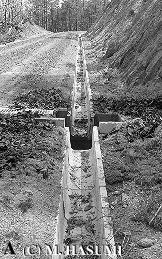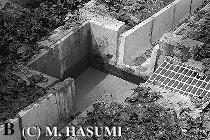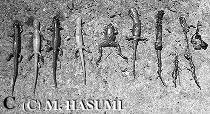


 |  |
 |
(B) A catch basin, settled every 20 m distance along the entire length of the ditches, always including water. Amphibians, dropped into the ditches, are carried by water whenever rainy or walk by themselves to the catch basin. A right material is an opening of a culvert.
(C) Dead amphibians obtained from decaying leaves accumulated in the present catch basin. From left to right, there are four gravid females of the salamander Onychodactylus japonicus, one male of the frog Rana ornativentris, one unsexed individual of the salamander Hynobius lichenatus, and several injured individuals of unknown species.
I took these photographs on 5 May 1983 in Genbi, Ichinoseki-shi, Iwate Prefecture, Japan (approximately 400 m elevation). In this report (Hasumi, 1984), I claimed that a slope should be attached to part of a ditch in order to help small animals' escape.
*Note the absence of black claws at the tip of the finger or toe in those four "gravid" females of O. japonicus. The claws are believed to have already developed in breeding immigrants of this species.
Hasumi, M. 1984. Drains of forest roads, as a trap for salamanders. Collecting and Breeding (Tokyo) 46(5): 222-223. (In Japanese)